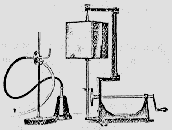
Koenig's manometric flame apparatus
Encyclopedia

Germany
Germany , officially the Federal Republic of Germany , is a federal parliamentary republic in Europe. The country consists of 16 states while the capital and largest city is Berlin. Germany covers an area of 357,021 km2 and has a largely temperate seasonal climate...
physicist Rudolph Koenig
Rudolph Koenig
Karl Rudolph Koenig , known by himself and others as Rudolph Koenig, was a German physicist, chiefly concerned with acoustic phenomena.Koenig was born in Königsberg , and studied at the University of Königsberg in his native town....
, and used to visualize sound waves. It was the nearest equivalent of the modern oscilloscope
Oscilloscope
An oscilloscope is a type of electronic test instrument that allows observation of constantly varying signal voltages, usually as a two-dimensional graph of one or more electrical potential differences using the vertical or 'Y' axis, plotted as a function of time,...
in the late nineteenth and early twentieth centuries.
Description
The manometric flame apparatus consisted of a chamber which acted in the same way as a modern microphoneMicrophone
A microphone is an acoustic-to-electric transducer or sensor that converts sound into an electrical signal. In 1877, Emile Berliner invented the first microphone used as a telephone voice transmitter...
. Sound from the source to be measured was concentrated by means of a horn or tube into one half of the capsule chamber. The chamber was divided in two by an elastic diaphragm, usually rubber. The sound caused the diaphragm to vibrate which modulated a flow of flammable illumination gas
Gas lighting
Gas lighting is production of artificial light from combustion of a gaseous fuel, including hydrogen, methane, carbon monoxide, propane, butane, acetylene, ethylene, or natural gas. Before electricity became sufficiently widespread and economical to allow for general public use, gas was the most...
passing through the other half of the chamber. The illumination gas was passed to a Bunsen burner
Bunsen burner
A Bunsen burner, named after Robert Bunsen, is a common piece of laboratory equipment that produces a single open gas flame, which is used for heating, sterilization, and combustion.- Operation:...
, the flame of which would then increase or decrease in size at the same frequency as the sound source.
The change in flame size was too fast to be easily seen with the naked eye and a stroboscope
Stroboscope
A stroboscope, also known as a strobe, is an instrument used to make a cyclically moving object appear to be slow-moving, or stationary. The principle is used for the study of rotating, reciprocating, oscillating or vibrating objects...
, usually in the form of a rotating many sided mirror was used to view the flame. The frequency of the sound could then be calculated from the apparent distance between the flame images in the mirror and the known speed of its rotation.
Alexander Graham Bell
Alexander Graham Bell
Alexander Graham Bell was an eminent scientist, inventor, engineer and innovator who is credited with inventing the first practical telephone....
used this type of equipment to study the performance of his microphones and demonstrated it in his display at the 1876
Philadelphia Centenarian Exhibition
Centennial Exposition
The Centennial International Exhibition of 1876, the first official World's Fair in the United States, was held in Philadelphia, Pennsylvania, from May 10 to November 10, 1876, to celebrate the 100th anniversary of the signing of the Declaration of Independence in Philadelphia. It was officially...
. He replaced the rubber diaphragm with an iron disc which was driven by an electromagnet
Electromagnet
An electromagnet is a type of magnet in which the magnetic field is produced by the flow of electric current. The magnetic field disappears when the current is turned off...
with current fed from a microphone. This apparatus was capable of giving quantitative measures of the performance of his microphones.
A type of fourier analyzer can be constructed by connecting a number of manometric flame capsules each to a helmholz resonator
Helmholtz resonance
Helmholtz resonance is the phenomenon of air resonance in a cavity, such as when one blows across the top of an empty bottle. The name comes from a device created in the 1850s by Hermann von Helmholtz, the "Helmholtz resonator", which he, the author of the classic study of acoustic science, used to...
tuned to either the fundamental frequency
Fundamental frequency
The fundamental frequency, often referred to simply as the fundamental and abbreviated f0, is defined as the lowest frequency of a periodic waveform. In terms of a superposition of sinusoids The fundamental frequency, often referred to simply as the fundamental and abbreviated f0, is defined as the...
of the sound to be analyzed, or one of its harmonic
Harmonic
A harmonic of a wave is a component frequency of the signal that is an integer multiple of the fundamental frequency, i.e. if the fundamental frequency is f, the harmonics have frequencies 2f, 3f, 4f, . . . etc. The harmonics have the property that they are all periodic at the fundamental...
s. The flames produced from each capsule are then an indication of the strength of each of the Fourier components of the sound.

